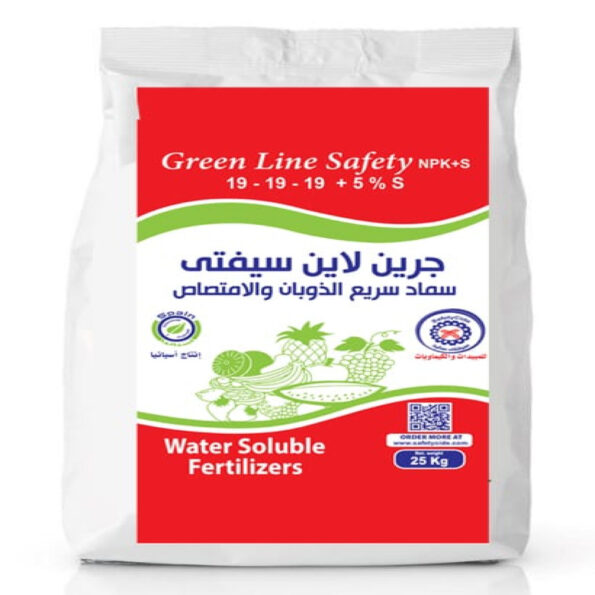
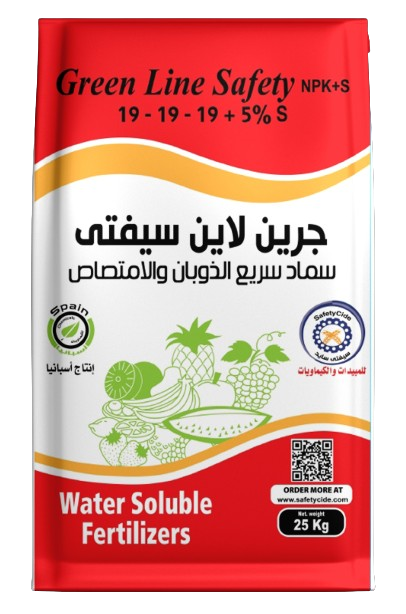
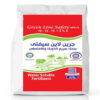

Green Line Safety
1.00EGP 0.00EGP
Installation:
Nitrogen: 19%
Phosphorus: 19%
Potassium: 19%
Compound features:
Potassium source fertilizer: Potassium nitrate is quickly soluble and absorbed
Phosphorus source fertilizer: urea phosphoric acid and diaminophosphate, which dissolves quickly and absorbs quickly.
High-purity crystalline fertilizer that is completely soluble in water
It has an acidic effect, which increases the ability of micro and macro elements to be absorbed
Branching increases in both vegetable and fruit crop seedlings
Green Line balanced fertilizer for foliar spray
Usage rates
| stage to use | Dosage (kg/acre/day) | The crop |
| Immediately after transplanting | 2-3 | Vegetables |
| Before flowering | 2-4 | the fruit |
| Branching stages | 1.5-2 | Field crops |
Based on 0 reviews
|
|
|
0% |
|
|
|
0% |
|
|
|
0% |
|
|
|
0% |
|
|
|
0% |
Related products
the definition:
Fina Bayer is available in the form of a concentrate that can be emulsified and the use of natural solvents makes the compound’s efficiency higher than the permeability through the skin of the caterpillars, as well as the local permeability in the leaf epidermis, which facilitates the access of the active substance to the larvae located under the leaf epidermis, such as (tunnel makers - Tuta absoluta).
Venapyr is an acaricidal and insecticide. It belongs to a new chemical group (pyrrole) that was discovered among natural insecticides.
Vinapyr is an acaricide with a very effective and long-lasting effect against various acaricides, thus protecting crops during the growing season with fewer sprays compared to many sprays with other pesticides.
Venapyr is an acaricide with a new, distinctive and effective formula against acaricides that have gained immunity from other acaricides. Tests showed that there are no strains resistant to the active ingredient chlorfenapyr.
Pre-harvest period, usage rate, crop pest
3 days 300 cm/acre beet fly sugar beet
21 days 75 cm/100 liters of water Citrus scale insects
Global connections:
Usage rate, crop lesion
250 cm/100 liters of onion thrips
50 cm/100 liters of water from potato manna
50 cm/100 liters of manna water, bean tunnel makers
100-125 cm/100 liters of water: aphids, whiteflies, cucurbit thrips
100 cm / 100 liters of water Aphids, whiteflies, mealybugs, scale insects, ornamental plants
100 cm / 100 liters of water, manna, jassid, peach - apricot
350 cm/acre, injected with drip irrigation for grape mealybugs
350 cm / 100 liters of water or 500 cm / acre by injection with drip irrigation Tunnel makers, mealybugs, citrus scale insects
20-30 cm/palm 100 cm/100 liters of water Red palm weevil, palm scale insects
Active ingredient: chloropyrifos: 48
Chemical group and organic phosphorus
the definition:
. Chlorestan is available in the form of an emulsifiable preparation
The use of natural solvents makes the compound more efficient in terms of permeability through the skin of the larvae, as well as local permeability to the leaf epidermis, which facilitates the access of the active substance to the larvae located under the epidermis of the leaf, such as (tunnel makers - Tuta absoluta).
Impact method
Chlorestan is well touched and contagious
Chlorestan causes rapid paralysis of treated insect pests, they stop feeding, and eventually die
Installation:
10%: Nitrogen
potassium:22%
Benefits of the compound:
Potassium nitrate: Soad is suitable for all irrigation systems and can be used as a spray on the leaves. It contains nitrogen in an easily absorbed form. This element is important for the formation of protoplasm, which makes up all living cells. It is also involved in the synthesis of amino acids, proteins, and chlorophyll.
It contains potassium in a high concentration in an easily absorbed form, which is the form of potassium nitrate. The element potassium has a large and important role in plants, as it
It helps in the activity of more than 10 enzymes, helps in photosynthesis, and regulates the process of opening and closing stomata. It is responsible for transporting nutrients to and from the cell, so it increases the sugar content in the fruits (Cantilever grapes).
It works to increase the germ content of the cell, so it works to increase the size of fruits (tomatoes, cucumbers, zucchini).
Potassium nitrate: It is preferable to use it on tuber crops such as (potatoes, yams, and onions), as it helps increase the plants’ ability to store, thus significantly increasing the size of the tubers and the yield.
Potassium nitrate: important for the formation of flowers and knots, so it is preferable to fertilize it during the flowering and licking stage
Usage rates: - Ground use: from 3-7 liters/acre depending on the crop and age of the plant. – Foliar use: from 22 cm/liter of water during the vegetative growth stage and before flowering
Installation:
Nitrogen:12%
Phosphorus: 12%
potassium:12%
Compound benefits
Vera fertilizer is characterized by containing balanced proportions of the major elements: nitrogen - phosphorus - potassium in the form of an easy-to-absorb grain. It is also loaded with a high percentage of amino acids, monosaccharides, and carboxylic acids, which expand and facilitate the absorption of major and minor elements through the leaves. Vera excels
A- With a high percentage of nitrogen, which facilitates foliar absorption and helps in the formation of a strong vegetative system.
2- The presence of a high percentage of phosphorus, which plays an important role in the flowering process and also works to warm the plant
3- Potassium, which facilitates foliar absorption, plays an important and major role in transporting nutrients to and from the cell. It also helps in the absorption of water, which increases the size of the fruits and the speed of their ripening. Stress over the news
Vera fertilizer contains amino acids that help the plant form a high concentration of hormones and enzymes and reduce the effect of...
Usage rates
Times of use: Drip irrigation, foliar spray per 100 liters of crop water
3-5 times 1 liter/acre 50-150 cm vegetables
4-6 times 1-2 liters/acre 50-200 cm of fruit
Installation:
Nitrogen:20%
%phosphorus: 20
% Potassium: 20
Compound features
X-Press is an integrated ground and foliar fertilizer that contains a group of macroelements and microelements that are quickly dissolved and absorbed
X-Press contains nitrogen, phosphorus and potassium in pure, easily absorbed forms, so it increases the total. The vegetative
X-Press treats the symptoms of macro- and micro-element deficiency in plants. X-Press reduces stress resulting from heat and frost
Usage rates
| stage to use | Dosage (kg/acre/day) | The crop |
| Immediately after transplanting | 2-3 | Vegetables |
| Before flowering | 2-4 | the fruit |
| Branching stages | 1.5-2 |
Field crops |
89 in stock
chemical composition:
Nitrogen: 5%
Magnesium: 8%
Compound features:
Magnesium nitrate: A liquid fertilizer that contains magnesium in the form of magnesium nitrate. Therefore, it is an easy fertilizer for plants to absorb and treats magnesium deficiency.
Liquid magnesium nitrate fertilizer is used through modern irrigation methods, as well as sprayed on the leaves
The importance of magnesium for plants
It is included in the synthesis of chlorophyll and participates in the movement of phosphorus in plants and in the exchange of carbohydrates
It affects the oxidation and reduction activity, and magnesium is included in the synthesis of the organic compound, which is considered the basic reserve of phosphorus
In case of magnesium deficiency, the chlorophyll content in the green parts of the plant decreases, and yellowing develops between the veins of the leaf, and the veins remain green.
A severe deficiency in the element magnesium leads to the marble appearance of the leaves, their twisting and yellowing, and the deficiency of this element appears on leafy crops in poor sandy and subsandy soils with an acidic reaction.
Usage rates
Ground use: from 3:1 liters/acre, depending on age and type of crop
Foliar use: 2-3 cm/liter of water during the vegetative, flowering and fruiting growth stages
سماد ورقي
جيل التركيب نيتروجين : ۶۲۰ – احماض امينية 45 % . ماغنسيوم %۱
امينوجيل سماد ورقي في صورة جيل يحتوي على نيتروجين وماغنسيوم واحماض أمينية حرة لجميع محاصيل الخضر والفاكه لتنشيط التمثيل الغذائي وزيادة طاقة النبات .
يحتوي على تركيز عالي من النيتروجين والاحماض الأمينية الحرة التي تقلل من تأثير الإجهاد الناتج عن الحرارة العالية والصقيع . يزيد بشكل عالي من النمو الخضري الزهري والثمري .
يساعد على تكوين الأوكسينات المسئولة عن عملية الاستطالة في السيقان وكذلك نمو البراعم يحتوي على عنصر الماغنسيوم الذي يدخل في عملية تكوين الكلوروفيل . برفع من انتاجية الفدان بشكل ملحوظ .
Usage rates
يضاف من 1-5 سم / لتر ماء ويكرر كل 10 ايام
75 in stock
chemical composition
Nitrogen:12%
Calcium: 20%
Compound features
Calcium nitrate: A liquid fertilizer that contains calcium in the form of calcium nitrate. Therefore, it is an easy-to-absorb fertilizer for plants and treats calcium deficiency.
Liquid calcium nitrate fertilizer is used through modern irrigation methods, as well as sprayed on the leaves*
The importance of calcium for plants
Calcium plays a major role in the process of assimilation of enzymes and neutralizing the acidity of the alkaline solution
Calcium plays a major role in resisting some diseases that affect plant leaves by nourishing the cell walls
Calcium gives good characteristics to fruits in terms of shape, storage and marketing
Usage rates
Ground use: from 10:2 liters/acre, depending on age and type of crop
Foliar use: 2-3 cm/liter of water during the vegetative, flowering and fruiting growth stages



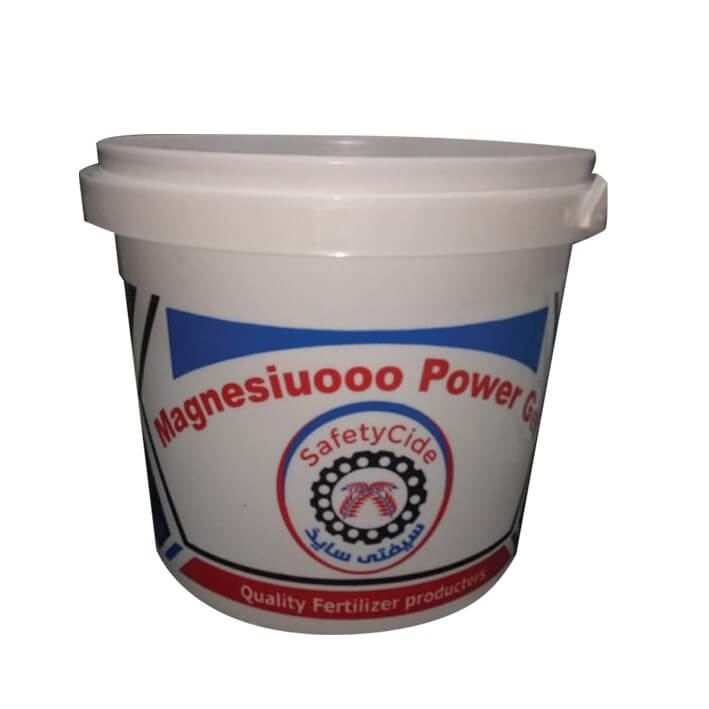
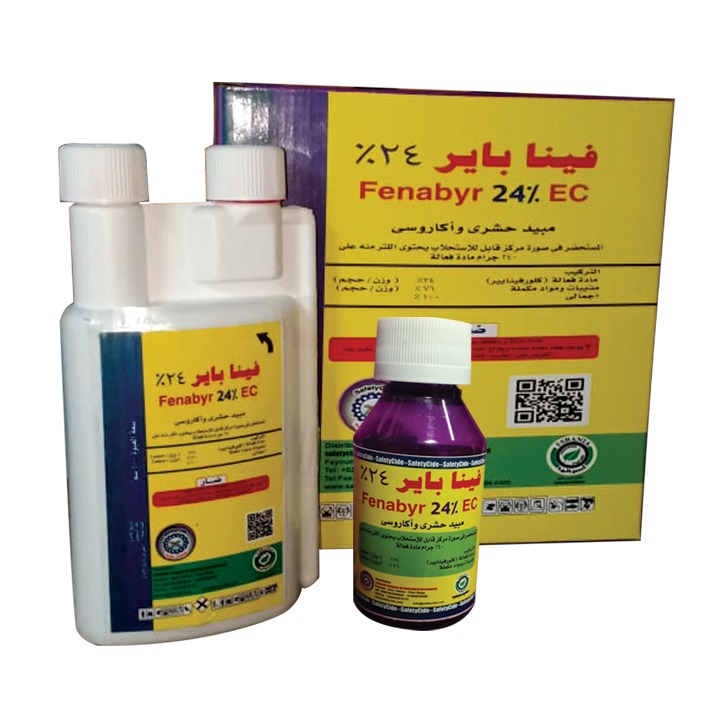
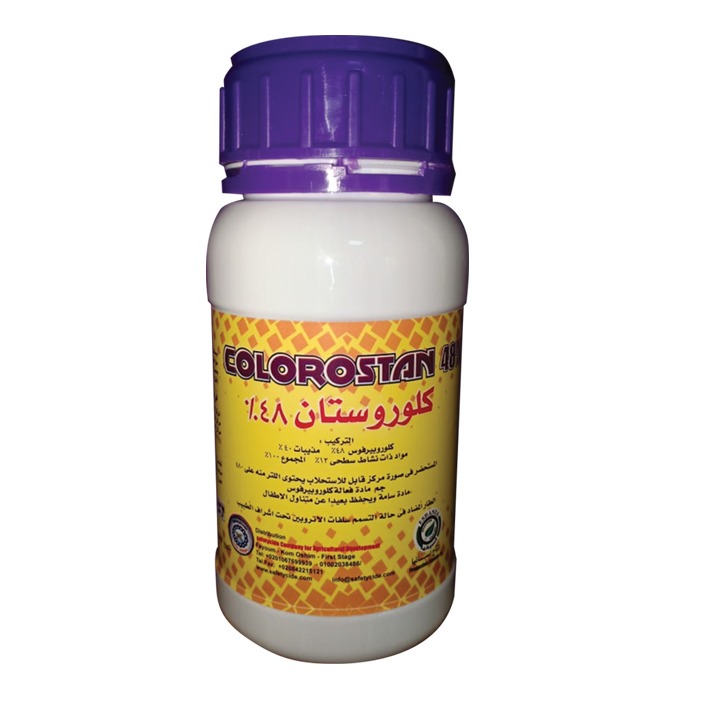

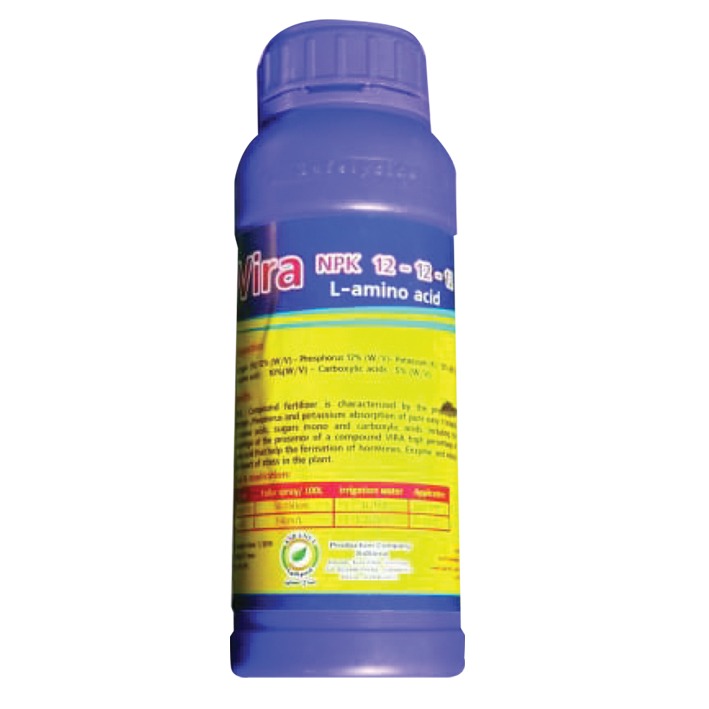
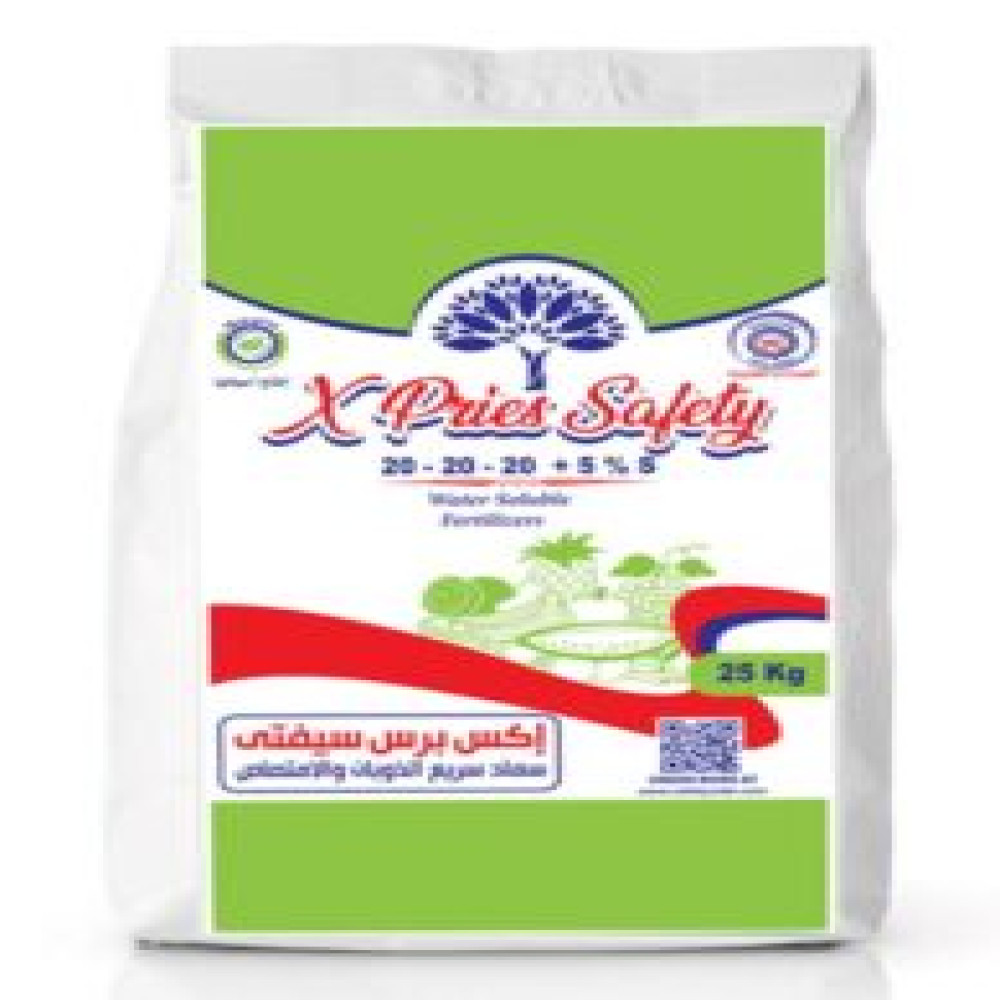



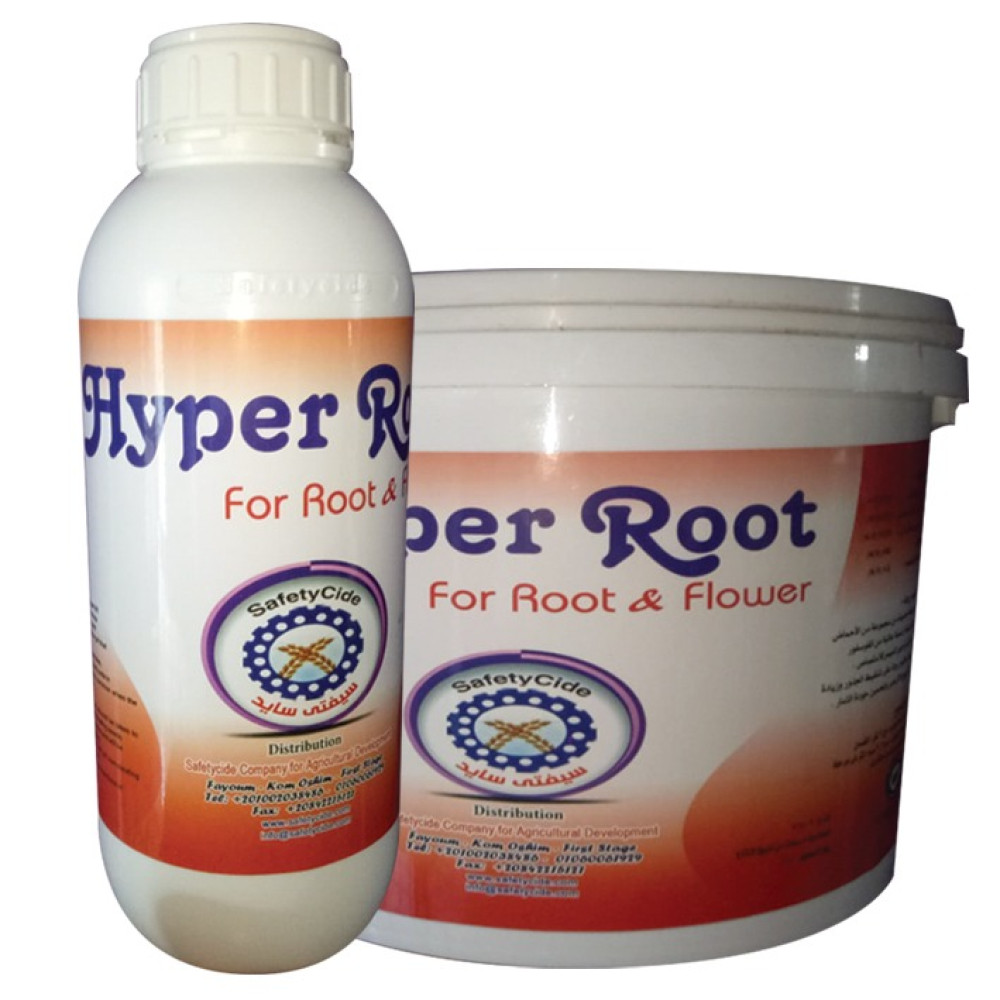

Reviews
There are no reviews yet.